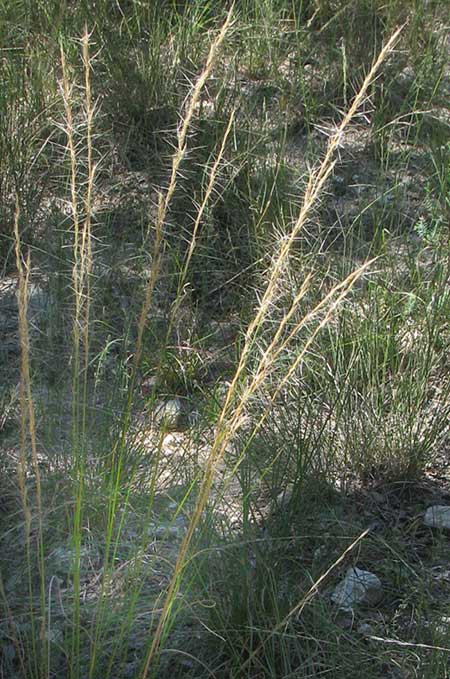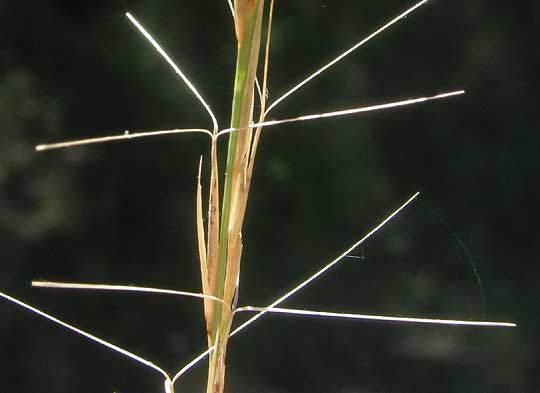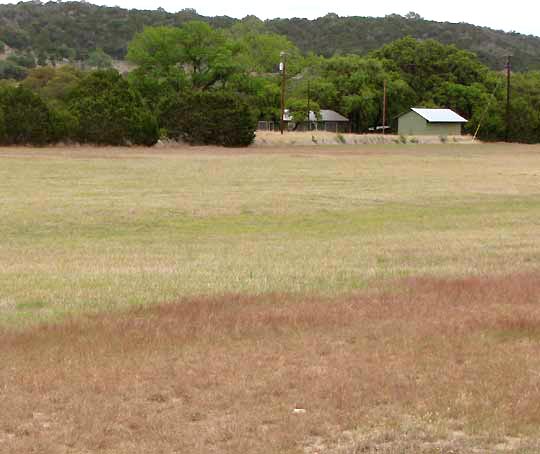Excerpts from Jim Conrad's
Naturalist Newsletter

from the the September 23, 2012 Newsletter issued from the valley of the Dry Frio River in northern Uvalde County, southwestern Texas, on the southern border of the Edwards Plateau; elevation ~1750m (~5750 ft); N29.62°, W99.86°; USA
PURPLE THREE-AWN GRASS
We're exactly where the Edwards Plateau with its hills and slopes of Cretaceous limestone meets the much younger gravels, sands, alluvium and other soft or loosely consolidated geologic materials of the Coastal Plain. The Edwards Plateau is a southern extension of the Great Plains with its grassy prairies. Therefore, we have interesting native grasses here, and I'm paying attention to them.
For example, on particularly dry limestone slopes where the Texas Live Oaks and Ashe Junipers grow far enough apart for plenty of sunlight to break through, often leg-high clumps of slender-stemmed grasses show up as shown above.
The Easterner might assume that this is one of the broomsedges, but a close look at the flowering heads dispels that notion. Broomsedges produce achene-type fruits equipped with white fuzz that helps the achenes disseminate in the wind. Our oak-juniper clumpgrass achenes are fuzzless, but from their tops arise three slender, stiff bristles that catch on animal fur for critter dissemination, and serve as crude parachutes for wind dissemination. The bristles are shown below:

This distinctive arrangement of three long, stiff bristles arising atop a slender achene tells us that we have a three-awn grass, a member of the genus Aristida. About 300 Aristida species are recognized worldwide, mostly growing in arid, warm regions like here; about 19 Aristida species are listed for Texas. The species in our picture seems to be the three-awn grass most typical for openings in forests of Texas Live Oak and Ashe Juniper, ARISTIDA PURPUREA, often known as Purple Three-awn Grass. It's found on dry, rocky soils on the Great Plains from Utah, Colorado and Kansas south through our area into northern Mexico.
Back when vast herds of buffalo roamed the American prairies this was one of the medium-size grasses they might have munched on if the herd wandered into dry, rocky spots. However, for grass eating herbivores Purple Three-awn Grass isn't a particularly palatable species, since its nutrient value isn't as good as some other species, plus, when the grass is fruiting, those long bristles stick in a grazer's throat and can cause sores in the stomach.
Still, small birds such as juncos eat the seeds, plus the grass produces a large network of fine roots, so an important service Purple Three-awn Grass provides for our rocky slopes is to hold the soil in place, which greatly benefits the whole ecosystem.
from the April 28, 2013 Newsletter issued from the Frio Canyon Nature Education Center in northern Uvalde County, southwestern Texas, on the southern border of the Edwards Plateau; elevation ~1750m (~5750 ft); N29.62°, W99.86°; USA
A PURPLE-HUED GRASS ON THE VALLEY FLOOR
This week the weather in our area has been warm enough but mostly overcast and with only one little shower that hardly settled the dust. In the resulting subdued light the Dry Frio Valley looked somber, but pretty, with a patchwork of soft greens emerging. Also, here and there on the grassy valley floor there were eye-pleasing patches of diffuse purple, as shown up front below:

Up close, clumps of this purple-topped grass are composed of many wispy stems with modest blades mostly clustered at stem bases, as shown below:

Closer still, the grass's purplish, unusually narrow individual flowers --or "florets" in grass terminology -- are seen to bear very long, slender, stiff, needlelike bristles, or "awns," which you can see below:

And much closer yet, each flower reveals itself as bearing three awns, shown below:

Until I saw the three awns shown in the last picture, I had no idea who the grass was causing the purple patches, but seeing those awns suddenly it occurred to me that we've already examined this species. Last September we looked at Purple Three-awn Grass, Aristida purpurea, and that's what we have again. Except that last September the grass was dry and straw-colored, and the awns atop the grass's matured grains stuck out at right angles to the grains, giving the fruiting heads a spiky look, as shown in our photo at the top of this page.
What a thing that a grass looking so peaceful and harmonious with the spring landscape can in the fall take on such an aggressive, skinhead-like look. And isn't it nice that by noticing the basic structure of things, true identities are discovered, no matter what the cosmetics or seasonal context?
entry dated April 6, 2022, issued from near Tequisquiapan, elevation about 1,900m (6200 ft), Querétaro state, MÉXICO
PURPLE THREE-AWN GRASS IN MEXICO

At the very edge of an old quarry from which local people take fill-dirt, much exposed to our late-dry-season heat, sunlight and dry wind, the above three-awn grasses formed a dense colony along the rim about 4m (4yds) long. It was the only three-awn grass I'd seen in the area, so it's not common at all. The above picture shows only the flowering parts, and notice that the panicle-type flowering head's branches hold close to the stem. Below, a single stem indicates the average size of the plants.

These are old plants and most of the leaves have broken off. Still, much of the plants' height is leafless stem.
One of the first things to check when identifying three-awn grass species is to determine whether the plants are annual of perennial. The bottom of this grass can be seen below:

Several shoots are clumped together, each one too hard and knotty to be the dead stem bases and roots of an annual. This is a perennial species. Now what does a spikelet with its mature caryopsis-type fruit like?

The spikelet at the left in the above picture has glumes of which the outer are only about 2/3 the height of the inner, and that's an important feature. Of the three awns atop the caryopsis, the middle one is a bit longer that the others. Below, the size of these items can be compared to my fingertips, which are about 12mm thick (half inch).

Of the 250-300 or so three-awn grass species, genus Aristida, here in the Bajío region of arid upland central Mexico about 14 have documented. Among those several are endemic just to Mexico, but this seems to be one distributed all the way from southwestern Canada to about here in central Mexico, Purple Three-awn Grass, ARISTIDA PURPUREA, of which we've seen a lot in Texas.
I didn't recognize our Mexican plants at first because these plants are shorter and with shorter awns than the Texas ones. However, over it's extensive distribution, the species manifests as several intergrading varieties, ours considered to be variety nealleyi. The online Flora of North America says that Purple Three-awn Grass stems can range from 10-100cm (4-40 inches), and the awns from 8-140mm (0.3-5.5 inches). Our nealleyi variety, the only variety documented for our region, is considered one with relatively short awns.